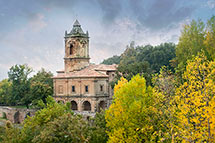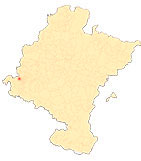Sanctuary of Nuestra Señora de Codés
Introduction
Although its exact origin is unknown, the sanctuary of Nuestra Señora de Codés experienced its period of greatest splendor during the 17th century, extending this golden age during the Age of Enlightenment. This is evidenced by the architecture of the sanctuary and its artistic endowment, together with the documentation that shows an increase in pilgrims and masses at that time, as well as the growing receipt of alms and gifts. However, late in the 18th century, the status of Codés began to change and at the end of the century a decline began that lasted practically throughout the 19th century. With the Napoleonic invasion and the War of Independence (1808-1814), the sanctuary served as barracks for troops of both armies, with the consequent deterioration, and lost its silverware when it was requisitioned by the French on November 6, 1809. On December 26, 1837, during the first Carlist war, the liberal Martín Zurbano sacked the sanctuary of Codés, considering it a refuge for Carlists, and set fire to the inn. The third Carlist war (1872-1876) also had a negative impact on the sanctuary, as can be deduced from the words that the chaplain Simón Valencia wrote to the bishop in 1880: "If it were not for the tower that crowns the church, Codés would look like a building abandoned to the elements...; the rooms are in such bad use that they take away the traditional devotion of coming to Codés".
However, the great revitalization of the sanctuary of Codés came with the new century with the help of the Cofradía Administradora del Basílica de Nuestra Señora de Codés, founded in 1901 to promote the cult of the Virgin of Codés, to conserve its church and its guest house, and to procure the sanctification of all its members. Numerous events testify to the new impulse of the sanctuary: a multitudinous pilgrimage in 1904, the minting of medals in 1905, the reprinting of the Ramillete de Juan de Amiax in 1906, or the subscriptions for a mantle (1906) or for the crowns of the Virgin and Child in 1908, which were imposed in a solemn ceremony the following year. The years ten were characterized by the beginning of the spiritual exercises directed by the Jesuits, as well as by the works carried out both in the church and in the guest house, which were inaugurated with great pomp in 1920. In the 1950s, Victor Eusa added modern outbuildings to the stables, and in the following decade a third floor was added to the complex. More recently, between 2007 and 2010, the Government of Navarre contributed to the last intervention, which mainly affected the rear façade, roofs, closings and surroundings.
AMIAX, J. de, Ramillete de Nuestra Señora de Codés, Pamplona, By Carlos Labayen, 1608.
History of Our Lady of Codés. Sencillos apuntes sobre Codés, Logroño, Cofradía Administradora del Santuario de Nuestra Señora de Codés, 1939.
ANDUEZA UNANUA, P, "El Santuario de Nuestra Señora de Codés: historia, arte y devoción", in FELONES MORRÁS, R. (coord.), En montes y valles. Santuarios en Tierra Estella, Estella, Cofradías de Nuestra Señora del Puy, Nuestra Señora de Codés y San Gregorio Ostiense, 2017, pp. 52-65.
AZANZA LÓPEZ, J. J., Arquitectura religiosa del Barroco en Navarra, Pamplona, Institución Príncipe de Viana, 1998.
GARCÍA GAINZA, M. C. and others, Catalog Monumental de Navarra. Merindad de Estella II**, Pamplona, Institución Príncipe de Viana, 1983.
ITÚRBIDE DÍAS, J., Between the Renaissance and the Baroque: Ramillete de Nuestra Señora de Codés (A bouquet of Our Lady of Codés)Piece of the month. Chair de Patrimonio y Arte navarro, 2016.
ORDOÑEZ, V., Santuario de Codés, Colección Temas de Cultura Popular nº 343, Pamplona, Diputación Foral de Navarra, 1984.











